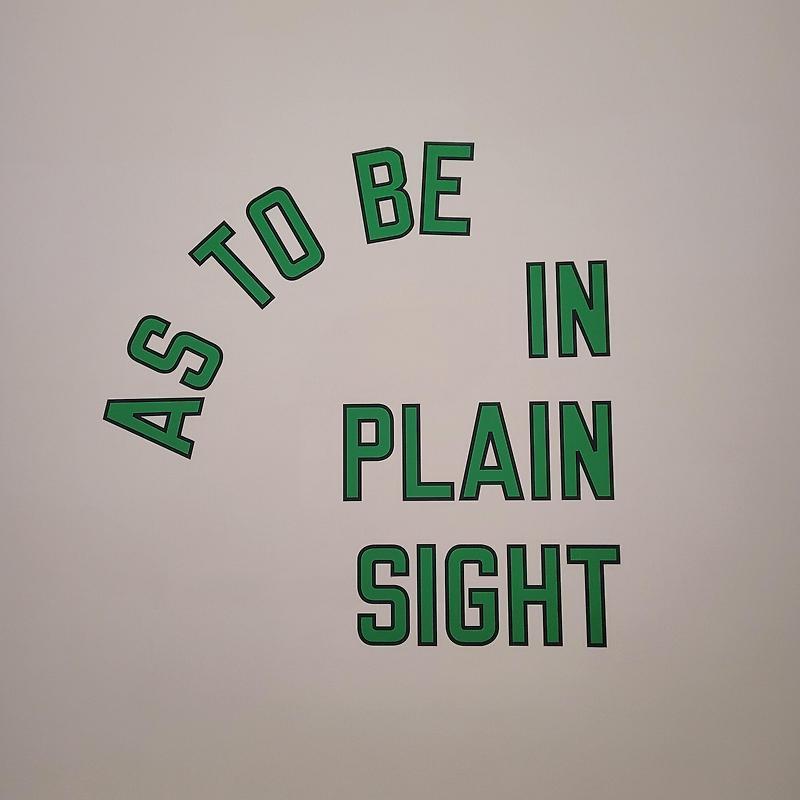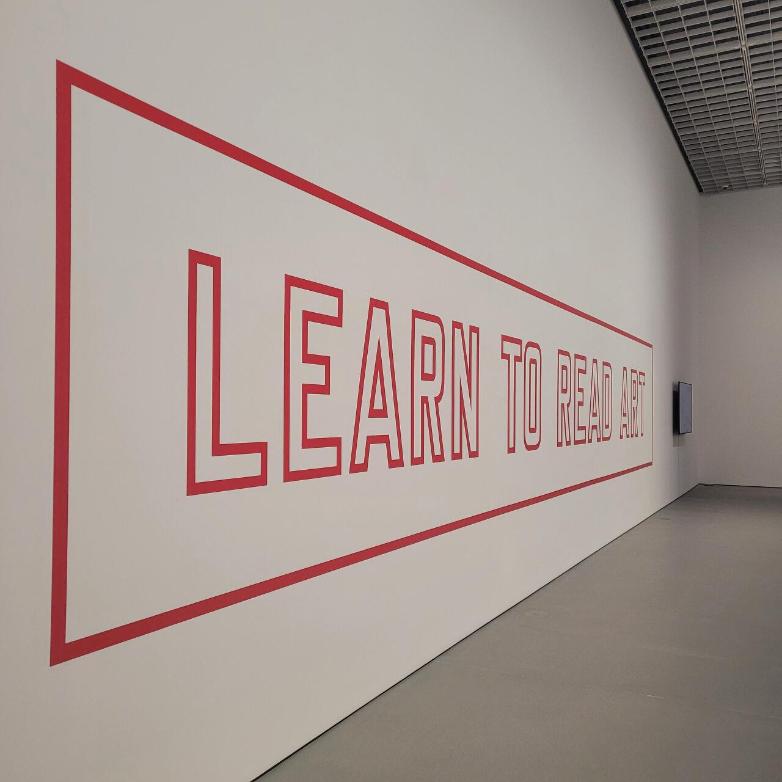Lawrence Weiner is an American conceptual artist known for his text-based works that explore the relationship between language, objects, and their meaning. As a leading figure in Conceptual ArtConceptual Art emerged in the 1960s as a movement that emphasized ideas and concepts over traditional aesthetic and material concerns. The movement challenges the traditional notion that the artwork must be a physical object, focusing instead on the intellectual engagement of the viewer. Sol Lewitt, Four-Sided Pyramid, 1999 Origins and Development Conceptual Art developed as artists began to question the More, Weiner’s innovative approach has had a profound influence on the way art is created, perceived, and understood.

Early Life and Career
Lawrence Weiner was born on February 10, 1942, in the Bronx, New York. He attended Stuyvesant High School and spent much of his youth working in various jobs and traveling across the United States. Weiner began his artistic career in the early 1960s, initially working with materials such as wood and steel. However, he soon shifted his focus to language as his primary medium, establishing himself as a pioneer in Conceptual ArtConceptual Art emerged in the 1960s as a movement that emphasized ideas and concepts over traditional aesthetic and material concerns. The movement challenges the traditional notion that the artwork must be a physical object, focusing instead on the intellectual engagement of the viewer. Sol Lewitt, Four-Sided Pyramid, 1999 Origins and Development Conceptual Art developed as artists began to question the More.
Artistic Style
Weiner’s style is characterized by:
- Text-Based Art: His works consist primarily of textual statements, often presented directly on walls or other surfaces.
- Conceptual Focus: Emphasizing the idea over the physical art object, his work invites viewers to engage with the meaning and implications of language.
- Minimalist Aesthetics: Weiner’s texts are often presented in a simple, unembellished manner, allowing the words to take center stage.
- Viewer Interaction: His art relies on the viewer’s interpretation and engagement, making the experience of reading an integral part of the work.

Major Works
- “At the Same Time”: This work features a textual statement on a ship.
- “Under The Sun”: A piece that uses language to evoke the universal and timeless presence of the sun, encouraging reflections on natural phenomena and their impact on human experience.
- “A 36″ x 36″ Removal to the Lathing or Support Wall of Plaster or Wallboard from a Wall” (1968): One of his early and influential works, this piece consists of a written instruction, emphasizing the concept and potential action over the physical artwork.
- “Many Colored Objects Placed Side by Side to Form a Row of Many Colored Objects” (1979): This work uses a straightforward description to provoke thoughts about color, arrangement, and perception.
- “Bits & Pieces Put Together to Present a Semblance of a Whole” (1991): This phrase, often installed in public spaces, invites viewers to consider the construction of meaning and the assembly of ideas.

Philosophical Influences
Weiner’s work is deeply influenced by his engagement with linguistic philosophy, semiotics, and conceptual thinking.
- Linguistic Philosophy: Inspired by philosophers such as Ludwig Wittgenstein, Weiner explores how language constructs meaning and shapes our understanding of reality.
- Semiotics: His work delves into the study of signs and symbols, examining how words function as carriers of meaning.
- Conceptual ArtConceptual Art emerged in the 1960s as a movement that emphasized ideas and concepts over traditional aesthetic and material concerns. The movement challenges the traditional notion that the artwork must be a physical object, focusing instead on the intellectual engagement of the viewer. Sol Lewitt, Four-Sided Pyramid, 1999 Origins and Development Conceptual Art developed as artists began to question the More: Weiner is a key figure in Conceptual ArtConceptual Art emerged in the 1960s as a movement that emphasized ideas and concepts over traditional aesthetic and material concerns. The movement challenges the traditional notion that the artwork must be a physical object, focusing instead on the intellectual engagement of the viewer. Sol Lewitt, Four-Sided Pyramid, 1999 Origins and Development Conceptual Art developed as artists began to question the More, a movement that prioritizes ideas and concepts over traditional aesthetic concerns.

Techniques and Materials
Weiner employs a variety of techniques and materials to achieve his distinctive style.
- Text on Walls: His works are often displayed directly on gallery walls, buildings, or public spaces, using paint, vinyl lettering, or other materials.
- Books and Publications: Weiner has published numerous books and catalogues that present his text works, extending their reach beyond physical installations.
- Language and Typography: The choice of words and their typographic presentation are central to Weiner’s practice, emphasizing clarity and directness.
Influence and Legacy
Lawrence Weiner’s impact on contemporary art is significant, particularly in the fields of Conceptual ArtConceptual Art emerged in the 1960s as a movement that emphasized ideas and concepts over traditional aesthetic and material concerns. The movement challenges the traditional notion that the artwork must be a physical object, focusing instead on the intellectual engagement of the viewer. Sol Lewitt, Four-Sided Pyramid, 1999 Origins and Development Conceptual Art developed as artists began to question the More and text-based art.
- Conceptual ArtConceptual Art emerged in the 1960s as a movement that emphasized ideas and concepts over traditional aesthetic and material concerns. The movement challenges the traditional notion that the artwork must be a physical object, focusing instead on the intellectual engagement of the viewer. Sol Lewitt, Four-Sided Pyramid, 1999 Origins and Development Conceptual Art developed as artists began to question the More: Weiner’s emphasis on language and ideas has been foundational for Conceptual ArtConceptual Art emerged in the 1960s as a movement that emphasized ideas and concepts over traditional aesthetic and material concerns. The movement challenges the traditional notion that the artwork must be a physical object, focusing instead on the intellectual engagement of the viewer. Sol Lewitt, Four-Sided Pyramid, 1999 Origins and Development Conceptual Art developed as artists began to question the More, influencing artists who prioritize concept over form.
- Public Art: His text works in public spaces have demonstrated the potential for art to engage with everyday environments and diverse audiences.
- Language in Art: Weiner’s innovative use of text has inspired a generation of artists to explore the intersections of language, meaning, and visual art.
Major Exhibitions and Collections
Weiner’s works have been featured in numerous major exhibitions and are held in prominent collections worldwide.
- The Museum of Modern Art (MoMA): New York’s MoMA has showcased Weiner’s works, highlighting his contributions to Conceptual ArtConceptual Art emerged in the 1960s as a movement that emphasized ideas and concepts over traditional aesthetic and material concerns. The movement challenges the traditional notion that the artwork must be a physical object, focusing instead on the intellectual engagement of the viewer. Sol Lewitt, Four-Sided Pyramid, 1999 Origins and Development Conceptual Art developed as artists began to question the More.
- Tate Modern: London’s Tate Modern features several of Weiner’s pieces, emphasizing his impact on contemporary art.
- Dia: This museum in Beacon, New York, houses significant works by Weiner, showcasing his text-based installations and conceptual projects.
Conclusion
Lawrence Weiner remains a pivotal figure in contemporary art, celebrated for his innovative use of language and his profound exploration of concepts. His contributions continue to influence and inspire artists and viewers, highlighting the enduring power of ideas in shaping our understanding of art and the world.
Further Reading
For those interested in exploring Lawrence Weiner’s life and work further, consider these sources:
